Splunk
Learn how to setup a BugSnag integration using Splunk.
The Splunk integration is available on Enterprise plans.
The Splunk integration will forward error information to Splunk as they are received and processed by BugSnag. Data is sent to a Splunk HTTP Event Collector (HEC).
Configuration
Set up event collector in Splunk
Your Splunk instance will need to be configured first to enable the HTTP Event Collector and add a new data input for BugSnag.
From your Splunk Dashboard select Data Inputs from the Settings menu.
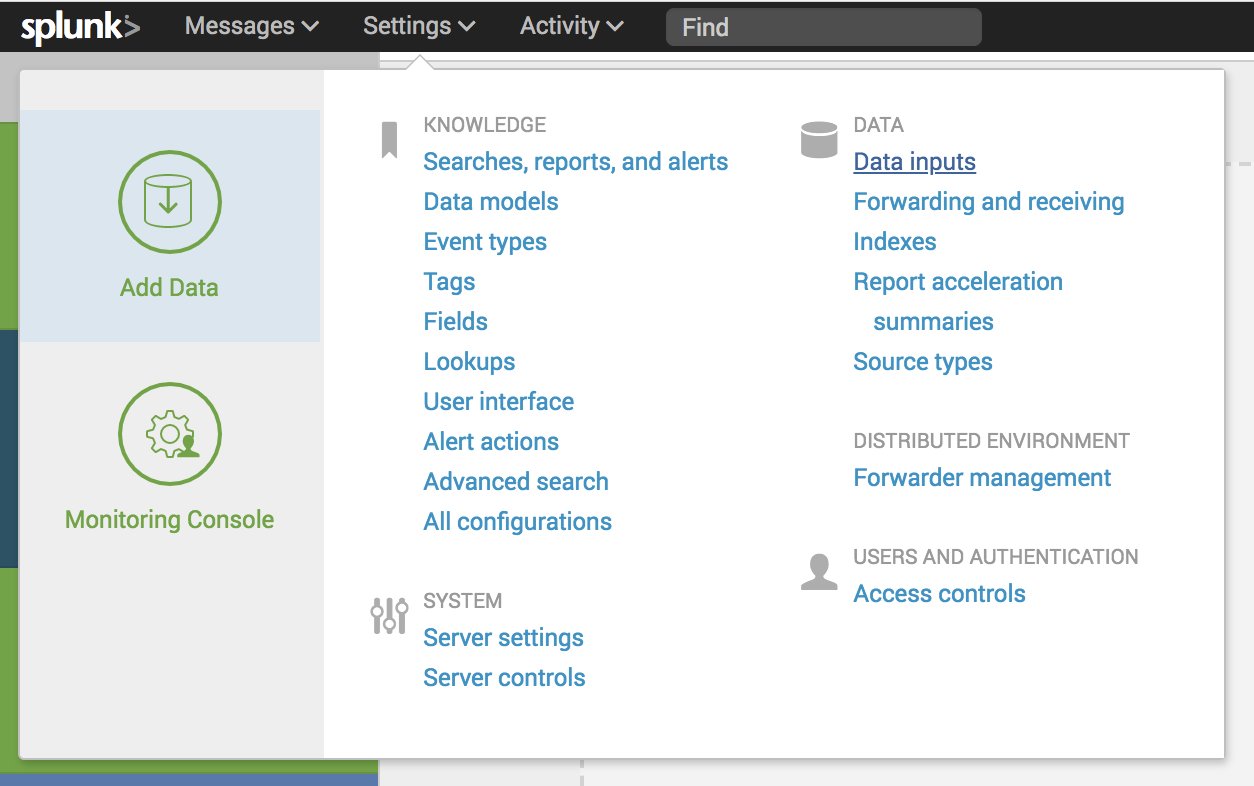
From the Data inputs page click HTTP Event Collector.
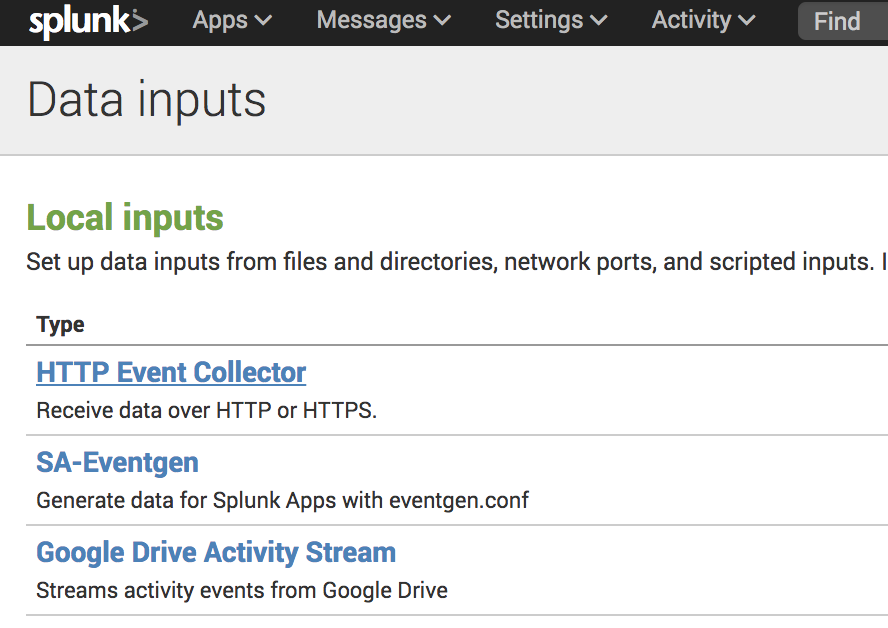
From the HTTP Event Collector page click the Global Settings button.
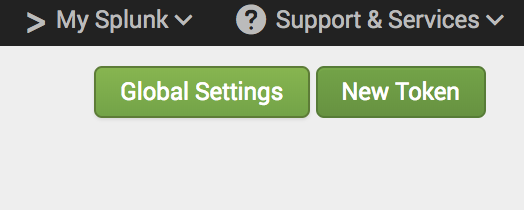
Make sure that All Tokens are set to Enabled. This is set to Disabled by default.
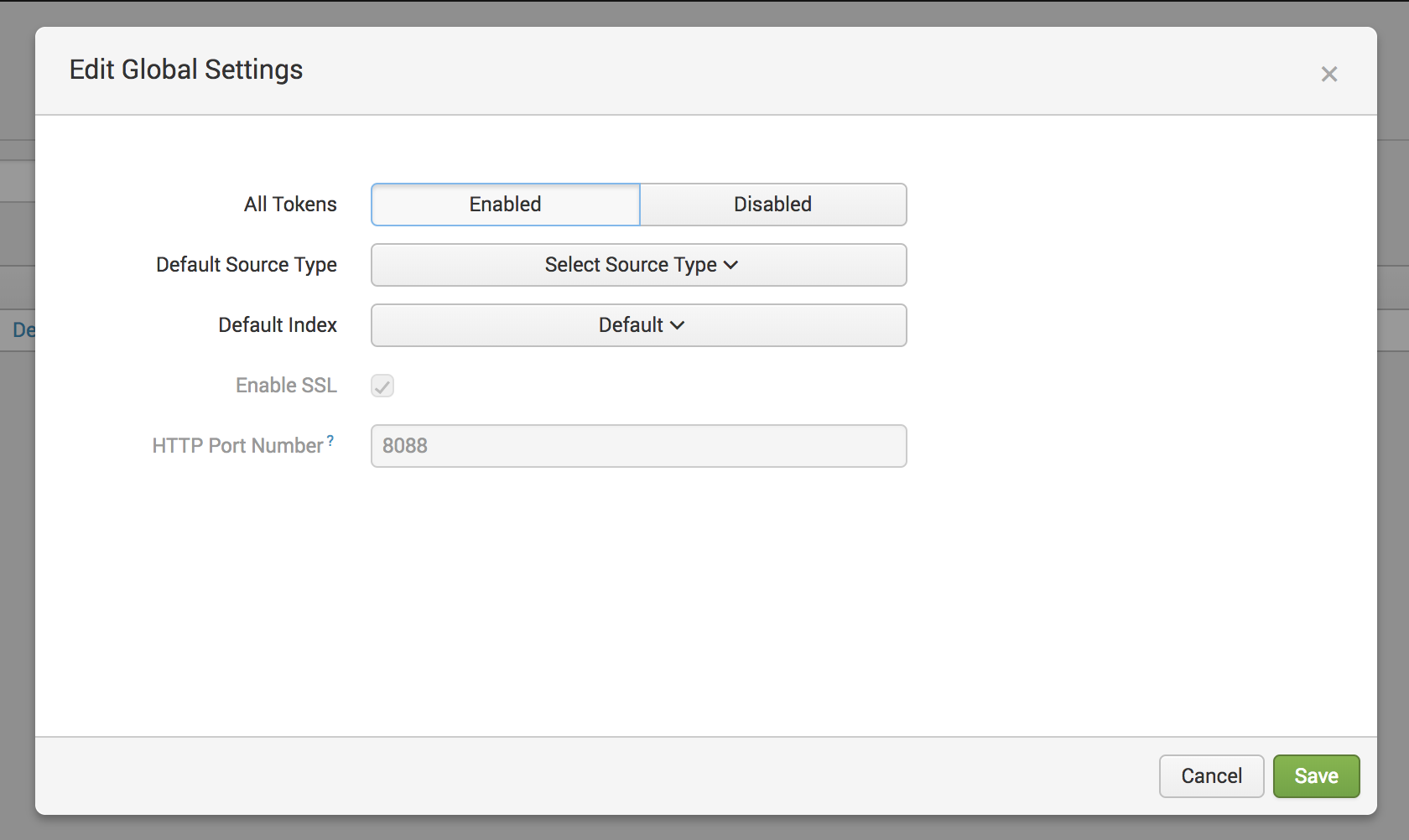 Make a note of the HTTP Port Number as this will be required when configuring BugSnag.
Make a note of the HTTP Port Number as this will be required when configuring BugSnag.Click the Save button.
Back on the HTTP Event Collector page click the New Token button. This will start the Add Data wizard.
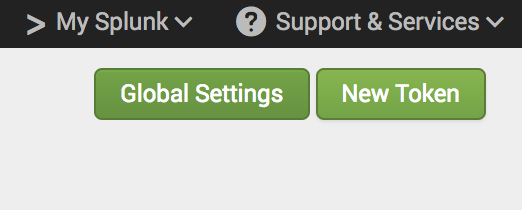
On the Select Source step add a Name of
Bugsnagand click the Next button.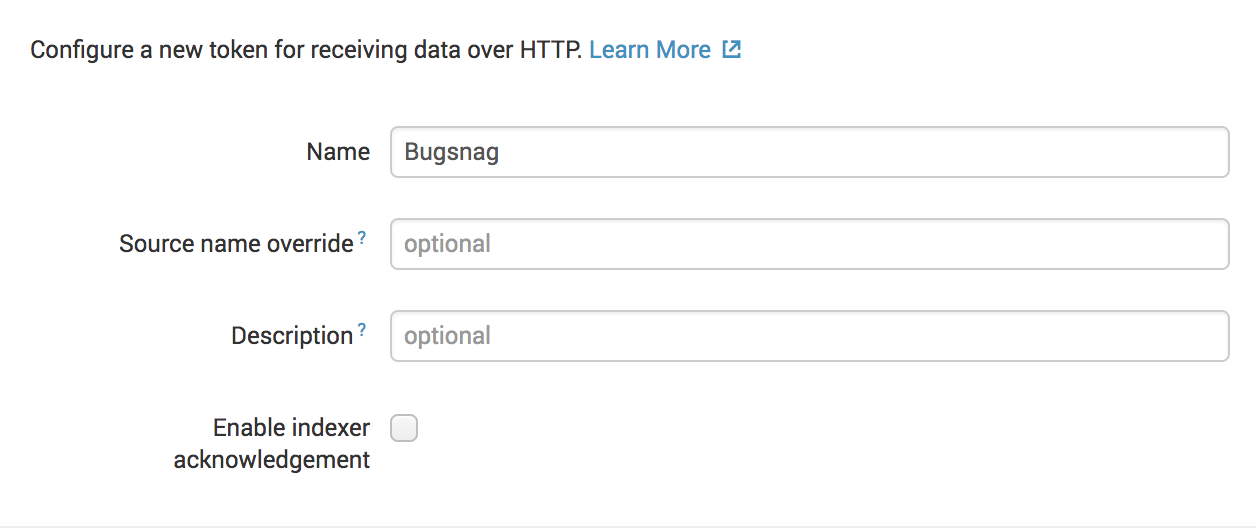
On the Input Setting step select the index to use for storing the incoming data from BugSnag and click the Review button.
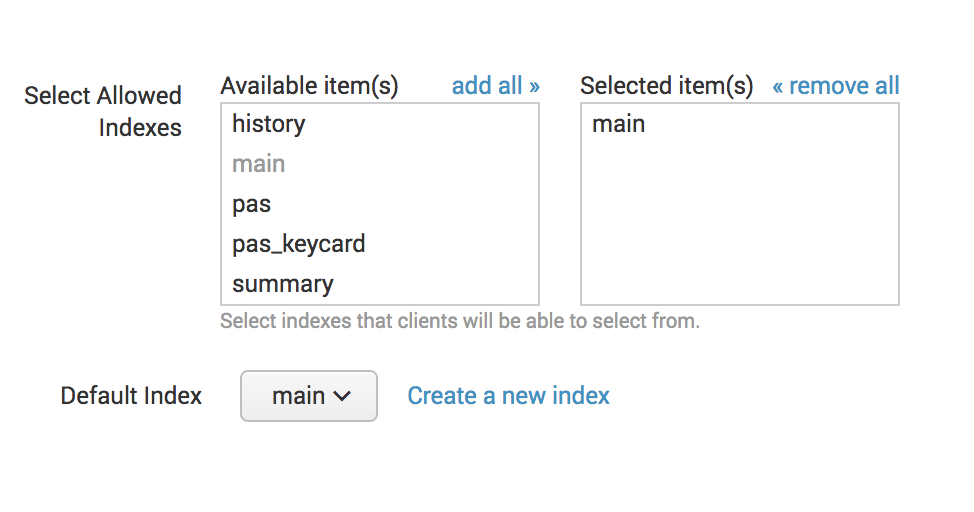
Check the details on the Review page and click Submit.

A token value will be presented in the next step. This will be needed for configuring BugSnag.

Configure integration in BugSnag
In Project Settings > Data forwarding, select Splunk from the list of available integrations.
The following configuration is required on the Configure Splunk dialog:
Splunk Instance URL
This is the HTTP Event Collector URL for the Splunk instance which will be receiving data from BugSnag. This should take the standard form:
https://<host>:<port>
Where:
<host>is the Splunk instance that runs the HEC<port>is the HEC port number
Index
This has to match the index configured in Splunk.
Source
Set this to be a value that identifies the source of the event, for example the name of the project.
HEC Token
This is the token displayed when configuring Splunk.
Ignore TLS certification validation
This option is required when HTTPS is enabled for the Splunk HTTP Event Collector but a self-signed certificate is present. Splunk Cloud uses self-signed certificates.
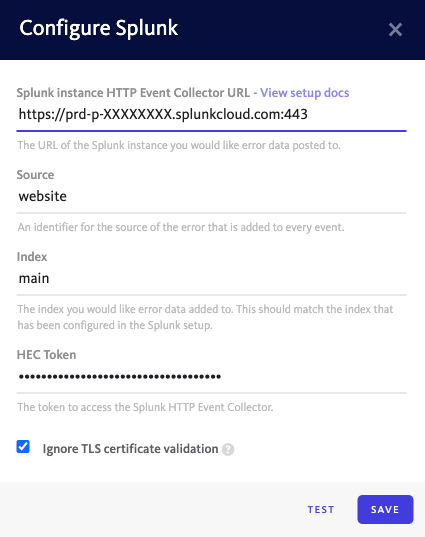
Click the Test button to check that the integration is configured correctly. This will send a test payload which can be viewed in Splunk.
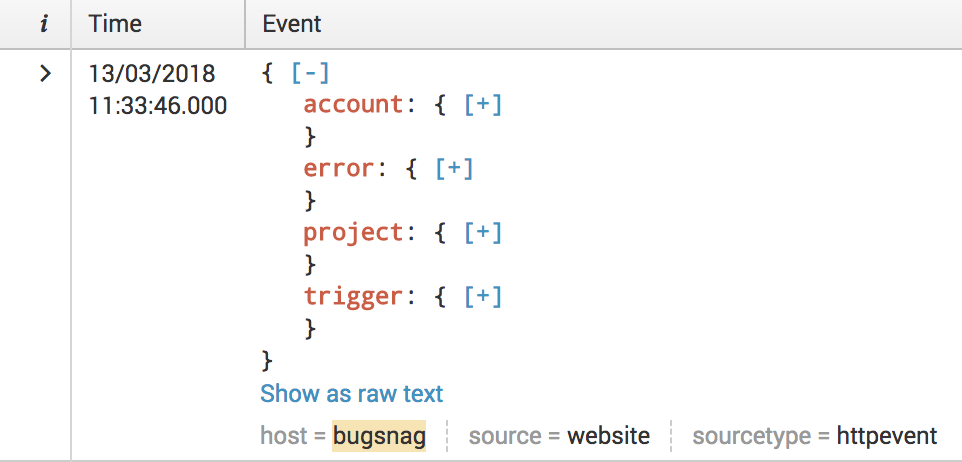
Click Save to display the Notify me when… dialog which can be used to configure triggers.
To configure real-time alerts and Splunk notifications in BugSnag Performance, see our dedicated documentation on Performance Monitors.
Triggers
The Splunk plugin can be configured to fire whenever the following triggers occur:
| Event | Trigger Name | Description |
|---|---|---|
| This project has a spike in errors | projectSpiking | An overall spike in all the errors that match your filter. |
| This project has a new release | release | A new release was created, either automatically from an error or session or via the Build API. |
| This project is being rate-limited | projectSamplingStarted | Your project is being rate-limited, if you have chosen rate limiting. |
| This project is close to being rate-limited | projectApproachingRateLimit | Your project is close to being rate-limited. Sent up to once per 2 hour period if you have chosen rate limiting and have a Standard or Enterprise plan. |
| A new error occurs | firstException | When the first event of an error (per release stage) matches your filters. |
| An error occurs frequently | errorEventFrequency | An error receives x events, or impacts x users, in y hours that match your filters, where you can define the number of events/users (x) and the time interval (y). A maximum of one notification will be triggered per time interval (y). |
| An error milestone is reached | powerTen | An error has occurred 10, 100, 1000 then each 1000 more times. |
| Every time an error occurs | exception | Every time an event matching your filters is received. |
| An error is automatically reopened | reopened | An error that has been marked as fixed or snoozed (and matches your filters) receives an event that causes the error to be reopened. |
| A collaborator comments on an error | comment | A collaborator on your project adds a comment to an error that matches your filter. |
| A collaborator changes the state of an error | errorState- ManualChange | A collaborator on your project manually changes the state of an error that matches your filter, for example marking an error as fixed. |
JSON payload
Here is the JSON payload that will be sent to Splunk when a trigger occurs:
{
// The account connected to the event (always present)
account: {
// The ID of the account (always present)
id: "56b9ca7f17025f8756f69054",
// The name of the account (always present)
name: "My Company",
// The URL to the account (always present)
url: "https://app.bugsnag.com/accounts/my-company"
},
// The project connected to the event (always present)
project: {
// The ID of the project (always present)
id: "56b9ca7f17025f8756f69054",
// The name of the project (always present)
name: "My Test Project",
// The URL to the project (always present)
url: "https://app.bugsnag.com/my-company/my-test-project"
},
// The reason why the payload was fired (always present)
trigger: {
// The type of trigger sent (always present)
// - "firstException" A new error is created from a new exception
// - "errorEventFrequency" An error occurs frequently
// - "powerTen" An error milestone is reached
// - "exception" Every time an exception is received
// - "reopened" An error is automatically reopened
// - "projectSpiking" A spike in exception in a project has been detected
// - "release" A new release was created
// - "projectSamplingStarted" The project is being rate-limited
// - "projectApproachingRateLimit" The project is close to being rate-limited
// - "comment" A comment is added to an error
// - "errorStateManualChange" A user has manually changed the state of an error
type: "exception",
// Detailed description of why the trigger was fired (always present)
message: "1000th exception",
// The snooze rule associated with the trigger, if applicable (optional).
// This can be the snooze rule that caused this event to occur if its reopened from
// archived, or the snooze rule connected to the user action of snoozing
// or cancelling a snooze.
snoozeRule: {
// The type of rule that (always present)
// - "occurrences" An error as reoccurred a number of times
// - "occurrence_per_hour" An error as reoccurred a number of times in an hour
// - "occurs_after" An error as reoccurred after a period of time
type: "occurrences",
// The number of occurrences or minutes (always present)
ruleValue: 10
},
// The number of events that have occurred in the project of the spiking time,
// if the trigger is project spiking (optional)
rate: 5000,
// The state change that occurred if the trigger is a manual error state change (optional).
// This can be "fixed", "reopened", "snoozed", "snoozeCancelled", "ignored"
// and "unignored".
stateChange: ""
},
// The comment details if a comment was added (optional)
comment: {
},
// The user that caused this trigger to fire if applicable (optional)
user: {
// A unique identifier for a user (always present)
id: "56b9ca7f17025f8756f69054",
// The user's name, or a string used to identify them (always present)
name: "Example User",
// The user's email address (always present)
email: "user@example.com"
},
// The event that caused this trigger to fire if applicable (optional)
error: {
// The ID of the event (always present)
id: "56b9ca7f17025f8756f69054",
// The ID of the error containing the event (always present)
errorId: "56b9ca7f17025f8756f69054",
// The name of the exception class from the event (always present)
exceptionClass: "NoMethodError",
// The message associated with the event (always present)
message: "Unable to connect to database.",
// A string representing what was happening in the application at the
// time of the error (always present)
context: "auth/session#create",
// The timestamp when the error was first created (always present)
firstReceived: "2015-11-27T15:26:11.000Z",
// The timestamp when this event was received (always present)
receivedAt: "2015-11-27T15:26:11.000Z",
// The request URL that caused the exception (optional)
requestUrl: "http://localhost:3000/admin/raise_exception",
// The ID of the user that the error is assigned to (optional)
assignedUserId: "5642494942656e7eac000004",
// The email of the user that the error is assigned to (optional)
assignedUserEmail: "assigned.user@example.com",
// The bugsnag URL to the event (always present)
url: "https://app.bugsnag.com/my-company/my-test-project/errors/56b9ca7f17025f8756f69054?event_id=56b9ca7f17025f8756f69054",
// The severity of the error (always present)
// - "error" the default for unhandled errors
// - "warning" the default when BugSnag.notify is called
// - "info" can be used in manual BugSnag.notify calls
severity: "error",
// The status of the error (always present)
// - "open" the error is open/new in BugSnag
// - "fixed" the error has been marked as fixed in BugSnag
// - "snoozed" the error has been snoozed in BugSnag
// - "ignored" the error has been ignored in BugSnag
status: "open",
// Whether or not the error was unhandled (optional)
// This can be set to:
// - true The error was detected by the notifier because it was not
// handled by the application
// - false The error was handled and reported using Bugsnag.notify
unhandled: true,
// If there are linked issues in an issue tracker then the details
// will be given here (optional)
linkedIssues: [{
// The ID of the issue in the issue tracker (optional)
id: "BUG123",
// The issue key in the issue tracker (optional)
key: "ENG-10",
// The number of the issue in the issue tracker (optional)
number: 3,
// The name of the issue tracker (always present)
type: "bugify",
// The url to view the issue (always present)
url: "http://demo.bugify.com/issues/3"
}],
// DEPRECATED: If there is a linked issue in an issue tracker, the details
// will be present here (optional). You should use `linkedIssues` instead.
createdIssue: {
// The ID of the issue in the issue tracker (optional)
id: "BUG123",
// The number of the issue in the issue tracker (optional)
number: 3,
// The name of the issue tracker (always present)
type: "bugify",
// The url to view the issue (always present)
url: "http://demo.bugify.com/issues/3"
},
// Information about the user affected by the error. Custom data
// will be included in the metaData object in a user object (optional)
user: {
// A unique identifier for a user affected by the event.
// This is a distinct identifier that makes sense for your
// application/platform (optional)
id: "19",
// The user's name, or a string you use to identify them (optional)
name: "Robert Hawkins",
//The user's email address (optional)
email: "bob@example.com"
},
// Information about the app where the error occurred. Custom data
// will be included in the metaData object in an app object (always present)
app: {
// A unique ID for the application (optional)
id: "com.bugsnag.android.example.debug",
// The version number of the application which generated the error (optional)
version: "1.1.3",
// The version code of the application (optional, Android/iOS/macOS/tvOS only)
versionCode: "12",
// The bundle version/build number of the application
// (optional, iOS/macOS/tvOS only)
bundleVersion: "1.0.2",
// A unique identifier to identify a code bundle release when using
// tools like AppCenter CodePush (optional, mobile only)
codeBundleId: "1.0-1234",
// A build ID that is required to identify a specific build when the
// version and version code are the same (optional, Android only)
buildUUID: "BE5BA3D0-971C-4418-9ECF-E2D1ABCB66BE",
// The release stage that this error occurred in, for example
// "development", "staging" or "production" (always present)
releaseStage: "staging",
// A specialized type of the application, such as the worker queue
// or web framework used, like "rails", "mailman", or "celery" (optional)
type: "rails",
// The UUIDs of the debug symbols file corresponding to this
// application, if any (optional)
dsymUUIDs: [
"e6173678256785afd940392abee"
],
// How long the app has been running for in milliseconds (optional)
duration: 1275,
// How long the app has been in the foreground of the device in
// milliseconds (optional)
durationInForeground: 983,
// Whether or not the app was in the foreground when the error
// occurred (optional)
inForeground: true,
// Whether or not the app was in the process of launching when the error
// occurred (optional)
isLaunching: true
},
// Information about the computer/device running the app. Custom data
// will be included in the metaData object in a device object (optional)
device: {
// The hostname of the server running your code, if applicable (optional)
hostname: "web1.internal",
// A unique identifier for the device (optional)
id: "fd124e87760c4281aef",
// The manufacturer of the device (optional)
manufacturer: "LGE",
// The model of the device (optional)
model: "Nexus 6P",
// The model number of the device (optional)
modelNumber: "600",
// The device's operating system name (optional)
osName: "android",
// The device's operating system version (optional)
osVersion: "8.0.1",
// The number of bytes unused in the device's RAM (optional)
freeMemory: 183879616,
// The number of total bytes in the device's RAM (optional)
totalMemory: 201326592,
// The number of unused bytes on the drive running the application (optional)
freeDisk: 13478064128,
// If a web application, the web browser used by the device (optional)
browserName: "Chrome",
// If a web application, the version of the browser used by the
// device (optional)
browserVersion: "61.0.3163.100",
// Whether or not the device has been modified to give users root
// access (optional)
jailbroken: false,
// The orientation of the device at the time of the error (optional)
orientation: "portrait",
// The locale of the device (optional)
locale: "en_US",
// Whether or not the device was currently charging at the time of
// error (optional)
charging: false,
// The battery level at the time of error, between 0 and 1 (optional)
batteryLevel: 0.99,
// The time that the error occurred (optional)
time: "2015-01-15T02:42:16.000Z",
// The timezone of the device (optional)
timezone: "PST"
},
// An object containing any further data attached to this
// error event (optional)
metaData: {
// Custom user data that is displayed in the User tab along
// with standard user fields on the BugSnag Website (optional)
user: {
...
},
// Custom app data that is displayed in the App tab along
// with standard app fields on the BugSnag Website (optional)
app: {
...
},
// Custom device data that is displayed in the Device tab along
// with standard device fields on the BugSnag Website (optional)
device: {
...
},
// Custom data that is displayed as an extra tab on the BugSnag
// website (optional)
someData: {
// A key value pair that is be displayed in the first tab (optional)
key: "value",
// This is shown as a section within the first tab (optional)
setOfKeys: {
key: "value",
key2: "value"
}
},
// This would be the second extra tab on the BugSnag website (optional)
someMoreData: {
...
}
},
// An array of user- and system-initiated events which led up to an error
// providing additional context, ordered newest to oldest (optional)
breadcrumbs: [{
// A short summary describing the event
// such as the user action taken or a new application state
name: "My breadcrumb",
// A category which describes the breadcrumb, from the list of allowed values
// "navigation", "request", "process", "log", "user", "state", "error",
// or "manual"
type: "manual",
// The time at which the event occurred
timestamp: "2015-01-15T02:42:16.000Z",
// An object containing extra information about the breadcrumb (optional)
metaData: {
...
}
}],
// An array of feature flags/experiments that were active when the error occurred.
// Each feature flag can have an optional variant.
featureFlags: [{
// The name of the feature flag (always present)
featureFlag: "share_ios_photo_sharing_button",
// The ID of the feature flag, unless the number of active features for the event has been exceeded (optional)
featureFlagId: "5f688f55d1befa016c94de00",
// The name of the variant (optional)
variant: "blue_button",
// The ID of the variant (optional)
variantId: "173c8f55d1befa016c94df1c"
}],
// An array of exceptions that occurred during this event. Most of the time
// there will only be one exception, but some languages support "nested" or
// "caused by" exceptions. The first item in the array represents the outermost
// exception. Each subsequent item represents the exception that caused the
// preceding one (optional).
exceptions: [
{
// The fully-qualified class name of the exception (optional)
errorClass: "NoMethodError",
// The string representation of the exception (optional)
message: "Unable to connect to database.",
// The type of the exception based on the originating platform (optional)
type: "ruby",
// An array of stacktrace objects. Each object represents one line
// in the exception's stacktrace (optional).
stacktrace: [
{
// Whether or not this line is in the user's project code (always present)
inProject: true,
// The line of the file that this frame of the stack was in (optional)
lineNumber: "1234",
// The column of the file that this frame of the stack was in (optional)
columnNumber: "123",
// The file that this stack frame was executing (optional)
file: "controllers/auth/session_controller.rb",
// The method that this particular stack frame is within (optional)
method: "create",
// The code in this file surrounding this line, up to three lines
// either side of the line that caused the problem (optional)
code: {
1231: " def a",
1232: "",
1233: " if problem?",
1234: " raise 'something went wrong'",
1235: " end"
1236: "",
1237: " end"
}
}
// An array of register details, e.g. for minidump stackframes (optional).
registers: [
{
// The index of the frame in the stacktrace that the registers apply to
// (optional)
frameIndex: 0,
// Details of a register (optional)
registerValues: [
{
// The name of the register (optional)
registerName: "rName",
// The value of the register (optional)
registerValue: "rValue"
}
]
}
]
]
}
// ...next "caused by" nested exception(s)
]
// DEPRECATED: An array of stacktrace objects. Each object represents one line
// in the exception's stacktrace. Where there are multiple exceptions (for
// example with languages that support "nested" or "caused by" exceptions)
// this will be the stacktrace of the outermost exception (optional). You
// should use `exceptions` instead.
stackTrace: [{
// Whether or not this line is in the user's project code (always present)
inProject: true,
// The line of the file that this frame of the stack was in (optional)
lineNumber: "1234",
// The column of the file that this frame of the stack was in (optional)
columnNumber: "123",
// The file that this stack frame was executing (optional)
file: "controllers/auth/session_controller.rb",
// The method that this particular stack frame is within (optional)
method: "create",
// The code in this file surrounding this line, up to three lines
// either side of the line that caused the problem (optional)
code: {
1231: " def a",
1232: "",
1233: " if problem?",
1234: " raise 'something went wrong'",
1235: " end"
1236: "",
1237: " end"
}
}]
},
// Information relating to a new release, if a new release occurred (optional)
release: {
// The ID of the release (always present)
id: "5a8ef30ed1befa487890a0fc",
// The version number of the application (always present)
version: "1.2.3",
// The version code of the application (optional, Android only)
versionCode: "1234",
// The bundle version/build number of the application
// (optional, iOS/macOS/tvOS only)
bundleVersion: "1.2.3",
// The release stage the release was released to e.g. production,
// staging (always present)
releaseStage: "staging",
// The URL to the release (always present)
url: "https://app.bugsnag.com/bugsnag/website/releases/5a8ef30ed1befa487890a0fc",
// The time the release was released (always present)
releaseTime: "2018-02-23T16:42:16.080Z",
// The person the release was released by, if provided (optional)
releasedBy: "John Smith",
// The source control information related to the release, if provided (optional)
sourceControl: {
// The name of the source control provider that contains the source code for
// the build (always present)
provider: "github",
// The source control SHA-1 hash for the code that has been built ,short or
// long hash (always present)
revision: "2ea8b513f049e8b9db8d3ad4f148242c422bb9e6",
// The URL to the revision of the release (always present)
revisionUrl: "https://github.com/bugsnag/website/tree/2ea8b513f049e8b9db8d3ad4f148242c422bb9e6",
// The URL to the diff between this release and the previous release, if
// applicable (optional)
diffUrl: "https://github.com/bugsnag/website/compare/2ea8b513f049e8b9db8d3ad4f148242c422bb9e6...2ea8b513f049e8b9db8d3ad4f148242c422bb9e6"
},
// Key value pairs containing any custom build information that provides useful
// metadata about the build. e.g. build configuration parameters, versions of
// dependencies, reason for the build etc. The keys and values are strings
// (optional).
metadata: {
"myKey": "myValue"
}
}
}
Access through firewall
If your server’s security policy denies access from external IP addresses and websites, you will need to allow access to the following IP addresses:
- 104.196.245.109
- 104.196.254.247
- 107.23.160.224
- 34.231.155.113
- 34.235.33.231
- 52.207.146.211
- 52.55.78.127
Or if you are using On-premise, you will need to allow access to the address specified in EXTERNAL_PROXY_URL.